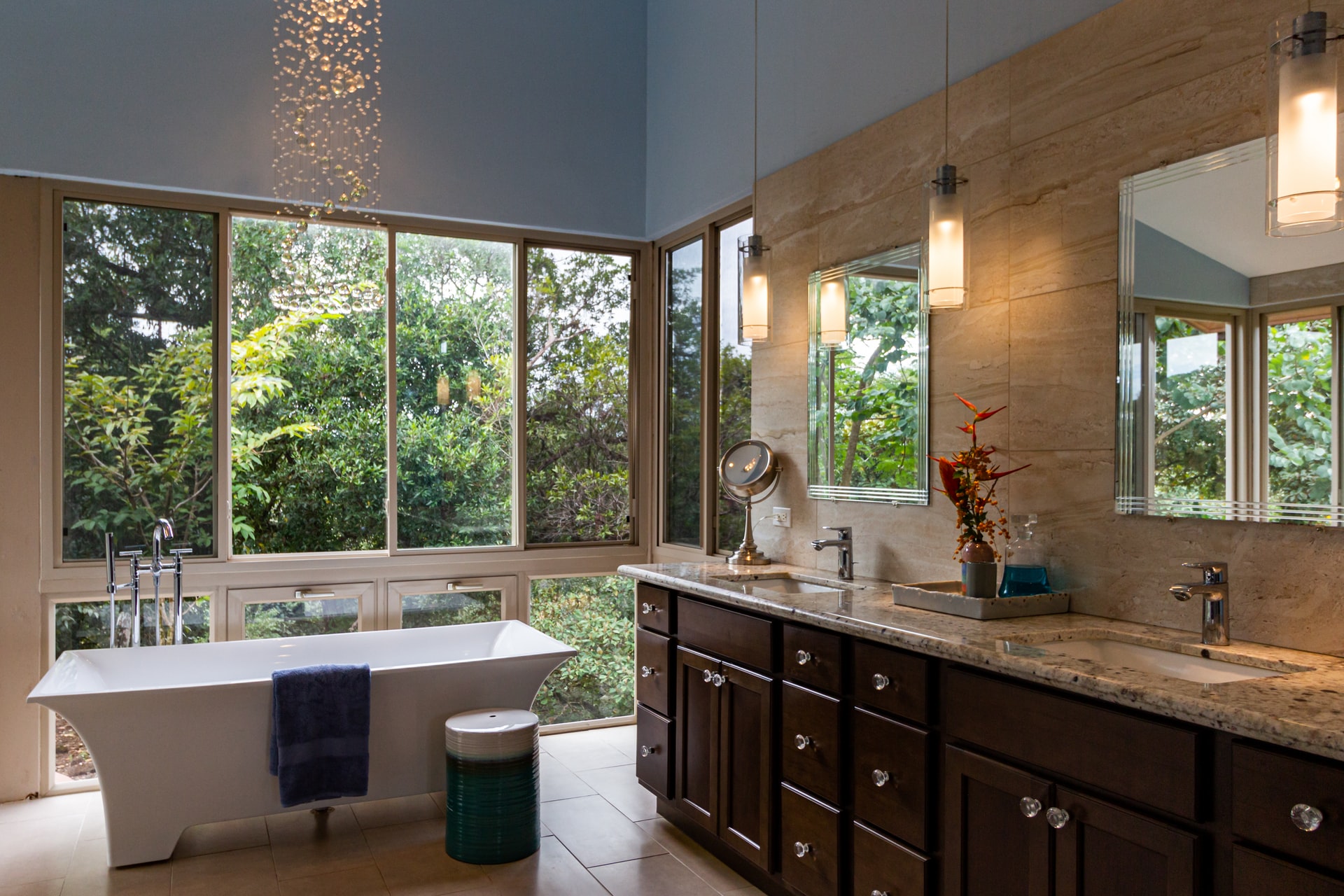You’ve installed energy-efficient windows throughout your home. You’ve opted for bamboo flooring over hardwood, swapped incandescent for LED light bulbs, and maybe you’re even pricing a solar power system or are already powered up by one. What more can you do to lead a more sustainable lifestyle? Easy—you can buy and install a composting toilet.
However, there are many factors to consider when adopting a composting or dry flush toilet. For one, you may live in an area or state where these toilets aren’t legal for use in homes. On the other hand, 27 states have legalized composting toilets, and many people are using them in their RVs, cabins, or tiny houses. Although primarily associated with people living off the grid, eco-friendly toilets are slowly attracting the attention of conventional homeowners, especially those who live in areas with water scarcity.
In this article, we’ll discuss the advantages and disadvantages of waterless composting toilets, helping you decide if this is the right option for your situation.
What is a composting toilet?
Essentially, a composting toilet relies on biological processes to break down human waste and convert it into compost safe for the landscape. Today, there are many different models of composting toilets, which can make choosing one challenge. However, all of the models dispense without the use of water. These are waterless toilets, which is why they’re often referred to as dry toilets. They don’t flush waste into sewer lines that feed into municipal septic systems. They are mainly enclosed systems (though there are some different models and composting systems that we’ll touch on later), making them ideal for people who live off the grid.
Often, people have lots of questions concerning dry toilets. For instance, what type of toilet paper can be used with them? Are there unique concerns associated with their use for menstruating women? First, any kind of toilet paper can be used. Additionally, as a human byproduct, blood can be introduced to the composting toilet with no problem. In the subsequent discussion, we’ll address other questions associated with these toilets and their operation.
How do composting toilets work?
Again, there are different types of composting toilets available today. However, these systems all work by relying on anaerobic organisms to break human waste into usable compost. The toilets must sustain an environment that is conducive for the bacteria and their work. This may involve some maintenance solutions, which we’ll also discuss. If the toilet doesn’t support an ideal environment for the bacteria, waste won’t be broken down effectively, and the toilet is apt to smell.
In a traditional toilet and sewage system, of course, people flush away their waste so that it doesn’t linger on the premises except in the case of septic systems. It takes a significant amount of clean water to flush a household’s waste down the drain. This use takes up about 30% of a home’s annual water use. According to the Environmental Protection Agency (EPA), this percentage may be higher in homes with older toilets. Not surprisingly, many people are interested in composting toilets to conserve water and save money on their monthly water bills.
Composting toilets have slightly more in common with septic systems. However, septic systems are also water-based systems. When homes with a septic system flush, the water flushes waste into the septic tank located on the property. Within the tank, organisms are at work, breaking down waste. Once broken down, the system pumps the trash into the drain field, typically located in the backyard, where it remains buried—unless something goes wrong with the system and the waste contaminates the environment.
Septic systems can be challenging to maintain, mainly if something goes wrong, like a leak or system clog. A composting toilet is primarily a self-contained unit. The waste remains in the toilet, where it’s broken down for composting.
However, other composting toilet systems use separate cold composting tanks; in these cases, waste from the toilet must be transferred to the tank every so often for the composting process to complete. Other composting toilets might use earthworms to speed up composting; these toilets are called vermicomposting toilets.
For this article, however, we’ll be referencing the active composting toilets that are self-contained systems. Even within this category, there are various options to choose from. Some models may be designed with a fan or a heating element to help speed up the decomposition process. Some of the models separate liquid and solid waste, processing them differently. If you elect to go this route, you’ll want to research the different models to choose the ideal one for your setting.
Where Are Composting Toilets Permitted for Use?
Currently, 27 states have legislation related to legal composting toilet use; however, this legislation varies, so you’ll need to check with your state/local government to find out about legal composting toilet use in your area. Some states, for instance, allow composting toilet use but require an additional gray water disposal system; these states are West Virginia and South Carolina.
Some states, such as Alaska, Alabama, California, and Oklahoma, have no legislation against composting toilets. Other states like Massachusetts, Rhode Island, and Montana permit compost toilet use but with certain conditions. If you are considering purchasing a composting toilet, check with current legislation first.
The Benefits of Composting Toilets
Composting toilet’s pros and cons are many. We’ll explore them now. There are many composting toilets advantages that you should know about when deciding whether to buy one or not. We’ll outline some here.
Reduced Water Consumption
The average household can reduce their water consumption by 30%. That’s considerable water savings that also translates into cost savings. Just as you can reduce your water usage, you can reduce your utility costs too.
Few Maintenance Costs
Although composting toilets are often more expensive than conventional toilets (the prices for dry toilets may start around $600), they tend to require very little maintenance or ongoing expenses. The installation cost for a dry toilet is also less than a traditional toilet in most cases.
No Negative Environmental Impact
By using a composting toilet, you can lead a more eco-friendly life. Composting toilets do not harm the environment. You can add the compost directly to your landscape (avoid your edible plants, however) as topsoil.
Design Neutrality
Many neutral dry toilet designs won’t conflict with your decor.
Odor Management
Composting toilets are surprisingly odor-free when appropriately maintained. This is a decided advantage since many people are hesitant to purchase compost toilets because they’re worried about the smell.
What Are the Disadvantages of Dry Toilets?
Buyers should not ignore composting toilet disadvantages either. These toilets may not be ideal for everyone or every household—and certainly aren’t even allowed in many places. These are some of the most commonplace compost toilet cons to keep in mind:
Energy Required
Some composting toilets may require energy to power their fan. Traditional toilets, of course, do not rely on electricity.
Manual Handling
At some point, the composted material in the dry toilet must be handled. Keep in mind, however, that this material has effectively become topsoil. It’s not as messy or as unpleasant a situation as one might expect.
Size
Composting toilets are generally more prominent than traditional toilets. If you need a smaller one, you’ll need to search for compact sizes or a split system composting toilet.
Odor
If your dry toilet isn’t adequately maintained, it can smell. Therefore, you’ll want to pay close attention to your toilet’s maintenance needs. For most toilets, this maintenance is relatively minimal. You may be required to dump in some live carbon periodically. We’ll talk more about sustainable toilet maintenance next.
Maintenance and Care Tips for Composting Toilets
Any dry toilet you purchase will come with recommended maintenance tips from the manufacturer. Some toilets may need the addition of live carbon from time to time. Many composting toilet owners must introduce ash and straw into their toilet systems to help with the composting process. Periodic cleaning with water and baking soda is also typically required.
Don’t introduce chemicals into your composting toilet as they can destroy its anaerobic environment. Additionally, you may not want to raise the composted material into your landscape if you take certain medications. Although some drugs like birth control are harmless when composted, others may pose an environmental risk.
When buying a composting toilet, it is prevalent that you will have to assemble it independently. However, the installation process is not complicated; there are simply a few things to take into account, such as measuring the space for your toilet (as they are generally a bit wider than traditional toilets), attaching it safely to the floor, and making sure there is enough ventilation in the room to avoid odor issues. And if you are a DIY kind of person, there are also lots of websites that will guide you step by step through the process of building your composting toilet from scratch!
If you’re interested in using a composting toilet at home, at your cabin, or in your RV, you’ll have many makes and models to choose from today. Be sure you understand your selection’s maintenance needs before making your choice. And always remember to check with your municipality to determine if a composting toilet is legal in your setting.




